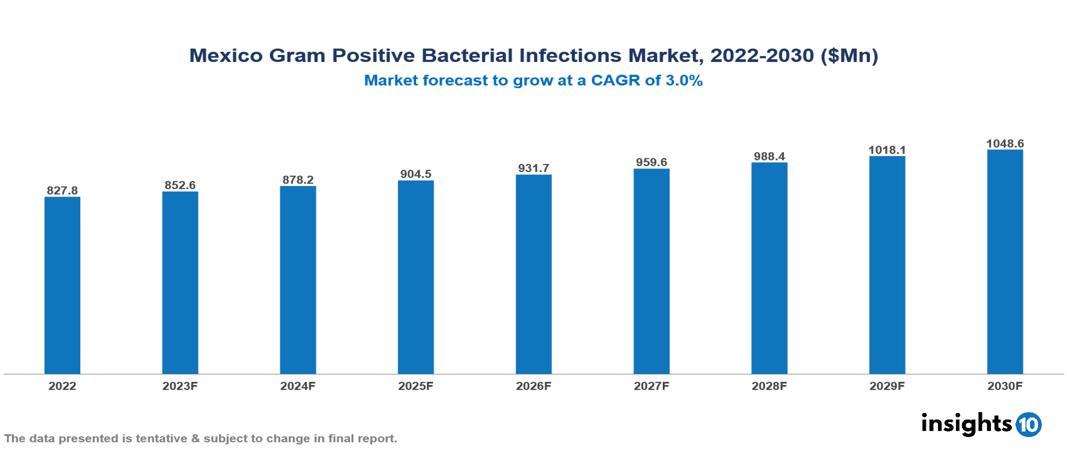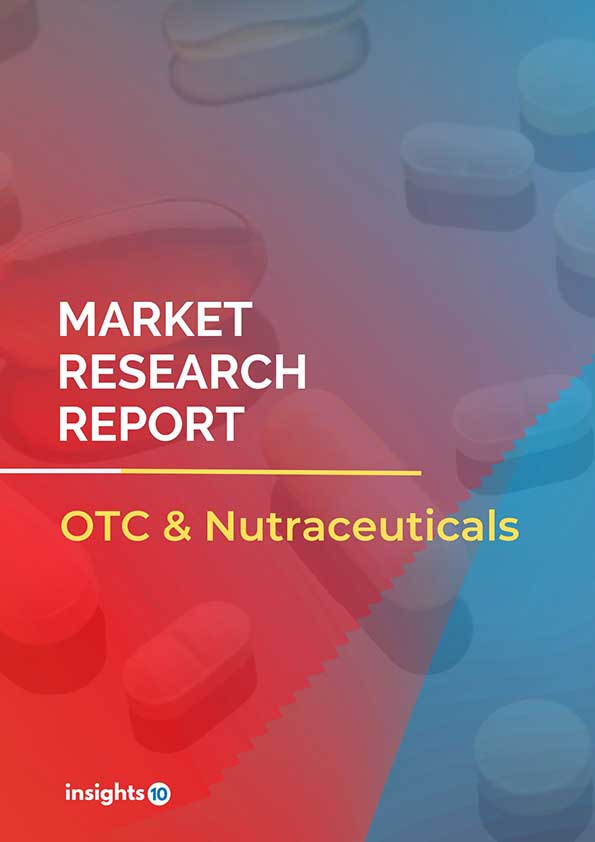Mexico Gram Positive Bacterial Infections Market Analysis
Mexico Gram Positive Bacterial Infections Market is projected to grow from $xx Mn in 2022 to $xx Mn by 2030, registering a CAGR of xx% during the forecast period of 2022 - 2030. Key drivers of the gram-positive bacterial infections market include the increasing prevalence of these infections, the emergence of antibiotic resistance, technological advancements in diagnostics and treatments, and the growing healthcare infrastructure, leading to higher demand for effective treatments and the need for innovative solutions to combat these infections. Global Players in Gram positive Bacterial Infections market are Pfizer Inc., Merck & Co., GlaxoSmithKline, Novartis AG, Sanofi S.A., Johnson & Johnson Services, AbbVie Inc., Bayer AG, AstraZeneca plc and Eli Lilly and Company.
Buy Now


Mexico Gram Positive Bacterial Infections Market Analysis Summary
Mexico Gram Positive Bacterial Infections Market is valued at around $827.8 Mn in 2022 and is projected to reach $1048.6 Mn by 2030, exhibiting a CAGR of 3% during the forecast period 2023-2030.
Key drivers of the gram-positive bacterial infections market include the increasing prevalence of these infections, the emergence of antibiotic resistance, technological advancements in diagnostics and treatments, and the growing healthcare infrastructure, leading to higher demand for effective treatments and the need for innovative solutions to combat these infections. Global Players in Gram-positive Bacterial Infections market are Pfizer Inc., Merck & Co., GlaxoSmithKline, Novartis AG, Sanofi S.A., Johnson & Johnson Services, AbbVie Inc., Bayer AG, AstraZeneca plc and Eli Lilly and Company.
Market Dynamics
Market Growth Drivers
- Prevalence: Infections caused by gram-positive bacteria, such as Staphylococcus aureus and Streptococcus pneumonia, are becoming more common, increasing the demand for efficient therapies
- Antibiotic resistance: The growth of antibiotic-resistant gram-positive bacteria needs the creation of new treatment alternatives, which drives market research and innovation
- Advances in diagnostics and treatment options, including novel antibiotics, vaccines, and antimicrobial therapy, are boosting market expansion
- Improving healthcare infrastructure: Improving healthcare infrastructure, particularly in developing countries, is increasing access to gram-positive bacterial infection detection and treatment
Market Restraints
- Expensive treatment: The expense of treating gram-positive bacterial infections, particularly those caused by antibiotic-resistant strains, can be prohibitively expensive, restricting affordability and accessibility
- Limited Treatment Options: In recent years, the development of novel antibiotics has been limited, resulting in a paucity of effective treatment choices for certain gram-positive bacterial infections
- Regulatory issues: Stringent regulatory regulations and lengthy approval processes for innovative medicines might cause difficulties for market participants
- Lack of awareness and diagnostics: Limited awareness about gram-positive bacterial infections and inadequate diagnostic facilities in certain regions can hinder early detection and treatment
Competitive Landscape
Key Player
- Pfizer Inc.
- Merck & Co.
- GlaxoSmithKline
- Novartis AG
- Sanofi S.A.
- Johnson & Johnson Services
- AbbVie Inc.
- Bayer AG
- AstraZeneca plc
- Eli Lilly and Company
1. Executive Summary
1.1 Disease Overview
1.2 Global Scenario
1.3 Country Overview
1.4 Healthcare Scenario in Country
1.5 Patient Journey
1.6 Health Insurance Coverage in Country
1.7 Active Pharmaceutical Ingredient (API)
1.8 Recent Developments in the Country
2. Market Size and Forecasting
2.1 Epidemiology of Disease
2.2 Market Size (With Excel & Methodology)
2.3 Market Segmentation (Check all Segments in Segmentation Section)
3. Market Dynamics
3.1 Market Drivers
3.2 Market Restraints
4. Competitive Landscape
4.1 Major Market Share
4.2 Key Company Profile (Check all Companies in the Summary Section)
4.2.1 Company
4.2.1.1 Overview
4.2.1.2 Product Applications and Services
4.2.1.3 Recent Developments
4.2.1.4 Partnerships Ecosystem
4.2.1.5 Financials (Based on Availability)
5. Reimbursement Scenario
5.1 Reimbursement Regulation
5.2 Reimbursement Process for Diagnosis
5.3 Reimbursement Process for Treatment
6. Methodology and Scope
Mexico Gram-Positive Bacterial Infections Market Segmentation
By Infection Type
- Staphylococcus Aureus Infections
- Streptococcus Pneumoniae Infections
- Enterococcus Infections
- Others
By Treatment Type
- Antibiotics
- Vaccines
- Antimicrobial Therapies
- Supportive Care?
By End-user
- Hospitals
- Clinics
- Ambulatory Surgical Centres
- Research Institutions
Methodology for Database Creation
Our database offers a comprehensive list of healthcare centers, meticulously curated to provide detailed information on a wide range of specialties and services. It includes top-tier hospitals, clinics, and diagnostic facilities across 30 countries and 24 specialties, ensuring users can find the healthcare services they need.
Additionally, we provide a comprehensive list of Key Opinion Leaders (KOLs) based on your requirements. Our curated list captures various crucial aspects of the KOLs, offering more than just general information. Whether you're looking to boost brand awareness, drive engagement, or launch a new product, our extensive list of KOLs ensures you have the right experts by your side. Covering 30 countries and 36 specialties, our database guarantees access to the best KOLs in the healthcare industry, supporting strategic decisions and enhancing your initiatives.
How Do We Get It?
Our database is created and maintained through a combination of secondary and primary research methodologies.
1. Secondary Research
With many years of experience in the healthcare field, we have our own rich proprietary data from various past projects. This historical data serves as the foundation for our database. Our continuous process of gathering data involves:
- Analyzing historical proprietary data collected from multiple projects.
- Regularly updating our existing data sets with new findings and trends.
- Ensuring data consistency and accuracy through rigorous validation processes.
With extensive experience in the field, we have developed a proprietary GenAI-based technology that is uniquely tailored to our organization. This advanced technology enables us to scan a wide array of relevant information sources across the internet. Our data-gathering process includes:
- Searching through academic conferences, published research, citations, and social media platforms
- Collecting and compiling diverse data to build a comprehensive and detailed database
- Continuously updating our database with new information to ensure its relevance and accuracy
2. Primary Research
To complement and validate our secondary data, we engage in primary research through local tie-ups and partnerships. This process involves:
- Collaborating with local healthcare providers, hospitals, and clinics to gather real-time data.
- Conducting surveys, interviews, and field studies to collect fresh data directly from the source.
- Continuously refreshing our database to ensure that the information remains current and reliable.
- Validating secondary data through cross-referencing with primary data to ensure accuracy and relevance.
Combining Secondary and Primary Research
By integrating both secondary and primary research methodologies, we ensure that our database is comprehensive, accurate, and up-to-date. The combined process involves:
- Merging historical data from secondary research with real-time data from primary research.
- Conducting thorough data validation and cleansing to remove inconsistencies and errors.
- Organizing data into a structured format that is easily accessible and usable for various applications.
- Continuously monitoring and updating the database to reflect the latest developments and trends in the healthcare field.
Through this meticulous process, we create a final database tailored to each region and domain within the healthcare industry. This approach ensures that our clients receive reliable and relevant data, empowering them to make informed decisions and drive innovation in their respective fields.
To request a free sample copy of this report, please complete the form below.
We value your inquiry and offer free customization with every report to fulfil your exact research needs.










































